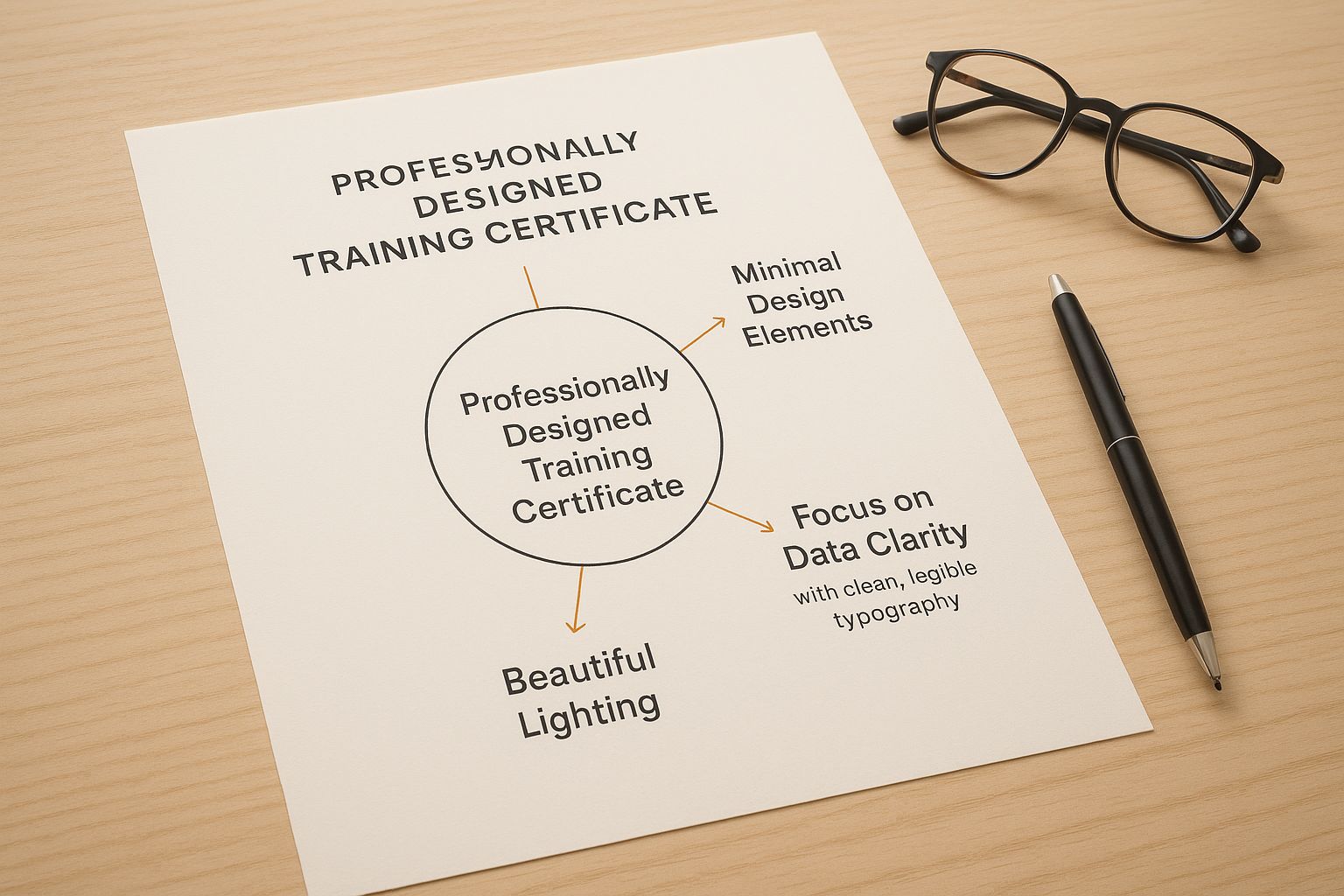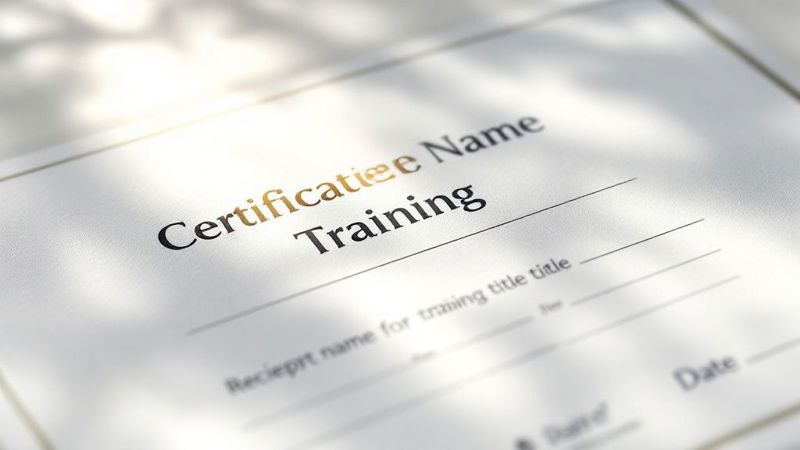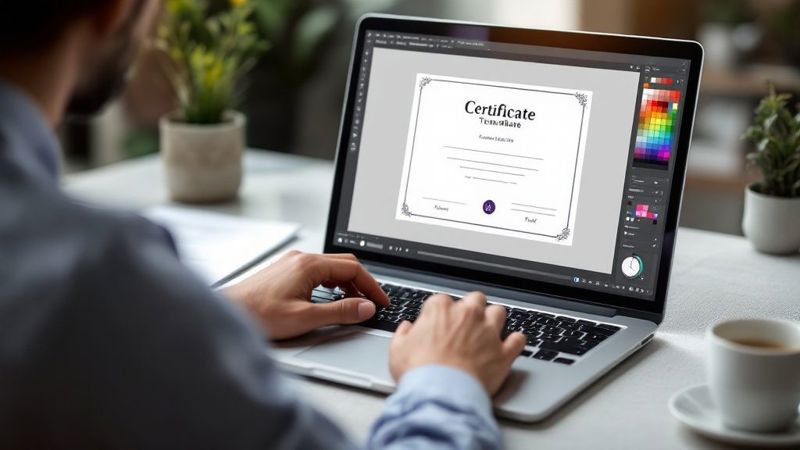Ever wonder what a training certificate template actually is? Think of it as a professional, pre-designed layout for acknowledging someone’s hard work after they’ve completed a course. It's essentially a blueprint for recognition, giving you a solid structure that you can quickly personalize with the trainee's name, the course details, and your company's branding.
So, Why Bother With a Template?
Instead of starting from scratch every single time you wrap up a training session, a template gives you a consistent and seriously efficient starting point. It’s like having a master key for professional development—it lets you produce high-quality, branded credentials without needing to be a graphic design whiz.
This simple tool does more than just save time. It's about giving employees something tangible that validates their new skills and helps build a culture where everyone is excited about learning. Using a standardized format also ensures every certificate looks professional, which boosts your training program's credibility.
If you’re mapping out a long-term growth strategy, a professional development planning template is a great way to structure that journey, with a certificate being the perfect final piece of recognition.
To give you a clearer picture, let's break down what a good template really offers.
Training Certificate Templates at a Glance
This table sums up the core purpose and benefits of using a training certificate template.
| Function | Key Benefit | Essential Component |
|---|---|---|
| Provides a pre-designed, professional layout. | Saves time and eliminates the need for design skills. | Company Logo & Branding |
| Establishes a consistent format for all awards. | Reinforces program credibility and brand identity. | Trainee Name & Course Title |
| Acts as tangible proof of skill acquisition. | Motivates employees and validates their effort. | Date of Completion & Signature |
In short, a template streamlines the entire process, from creation to distribution, while making sure your recognition efforts look polished and meaningful.
What a Good Template Really Does
A well-designed certificate of training template isn't just a piece of paper. It serves a few critical functions that make it incredibly valuable.
- Standardization: It ensures every certificate you hand out has a consistent, professional look that reinforces your brand. No more mismatched or amateur-looking awards.
- Efficiency: Templates slash the administrative time needed to create and send certificates, which is a lifesaver when you're dealing with large groups of trainees.
- Motivation: Let's be honest—people love getting recognized for their hard work. A formal certificate is tangible proof of achievement that boosts morale and encourages them to sign up for the next course.
Ultimately, starting with a great template is the first step toward creating a document people are genuinely proud to hang on their wall or share online. For more tips, check out our guide on how to make a certificate that employers actually value.
What Makes a Training Certificate Look Legit?
A good training certificate does more than just look pretty—it needs to project trust and authority. Think of it less like a piece of paper and more like a formal credential. To get that respect, it needs to have specific, non-negotiable elements that prove it's the real deal and that a genuine achievement has been made.
At a bare minimum, every certificate has to nail the basics to be valid. This isn't just about design; it's about creating a verifiable record of someone's accomplishment.
- Recipient’s Full Name: This ties the credential directly to the right person. No confusion.
- Training Course Title: It clearly states what skill or knowledge they actually gained.
- Issuing Organization: This shows who is vouching for the training.
- Date of Completion: It puts a timestamp on when the training was officially finished.
These are the foundational building blocks for a document that carries real-world weight.
This infographic breaks down exactly what components transform a simple template into a professional and credible certificate.

As you can see, a clean layout packed with clear, verifiable info is what turns a piece of paper into a trusted credential.
Building Trust with Details You Can Verify
To take a certificate from a simple "good job" to a formal credential, you have to add elements that prove its legitimacy. For example, an official signature or a company seal instantly makes the document an official record endorsed by your organization.
A unique certificate identifier or serial number is also a game-changer. This little detail allows employers or auditors to quickly check the certificate's validity against your own records, which is a powerful way to stop fraud and make it rock-solid.
A credible certificate is a verifiable one. Without elements that allow for easy verification, even the most beautifully designed certificate loses its professional weight and authority.
Modern certificate design also uses a surprising amount of white space—sometimes up to 30-40%—to keep things clean and readable. But the real shift is toward digital security, with features like QR codes and even blockchain verification becoming more common. These are essential for creating tamper-proof credentials that someone can verify in seconds, which is crucial for professional achievements. You can discover more insights about authentic certificate templates and how they lock in authenticity. These security features also make the accomplishment easy to share and verify online, ensuring its value lasts.
How Templates Elevate Your Training Program

Using a certificate of training template isn't just about saving a bit of time—it's a smart move that strengthens your entire professional development process. Templates are a fantastic tool for creating brand consistency, making sure every single certificate you hand out looks professional and carries your company's visual identity.
Think of it like a uniform. When every person who completes a course receives a document with the same high-quality design, it instantly builds brand recognition and reinforces the value of the training they just finished. That simple act turns a completed course into a credible, branded credential.
Ultimately, this consistency paints a unified and polished picture of your training programs.
Fostering Motivation Through Recognition
Beyond just looking good, the psychological impact on your team is huge. Getting a polished, official-looking certificate does more than just tick a box at the end of a course. It's a real validation of the recipient's hard work and dedication.
It transforms a simple training module into a proud, tangible accomplishment. This formal nod of approval can do wonders for morale, creating a sense of achievement that often fuels the ambition to learn even more. When people feel their efforts are officially recognized, they get more engaged and are far more likely to jump into the next training opportunity.
A well-designed certificate is a powerful, low-cost tool for employee recognition. It provides tangible proof of an individual's commitment to growth, fostering a culture where continuous learning is visibly celebrated and rewarded.
A great-looking certificate of training—which is easy to create with a professional template—can seriously boost your program by offering tangible recognition. It works much like other effective employee recognition program ideas. By standardizing the process, you guarantee every achievement is celebrated with the professionalism it deserves, leading to a more engaged and motivated workforce.
Top Platforms for Finding Certificate Templates
You don’t have to be a graphic designer to create a sharp, professional-looking certificate. Plenty of excellent online platforms are packed with high-quality templates, making it simple to produce official credentials in just a few minutes. These tools are built to be intuitive, so you can skip the technical headaches and focus on what really matters: recognizing achievement.
Industry favorites like Canva, Adobe Express, and Visme are brilliant places to start. Together, these platforms offer hundreds of free and premium templates that take the guesswork out of design. With easy drag-and-drop editors, anyone can add their own logos, tweak the text, and match brand colors without any design background.
Each platform has its own strengths, so the best one for you really depends on what you're trying to accomplish.
Canva: The User-Friendly Powerhouse
For most people, Canva is the go-to choice because of its incredible simplicity and massive template library. It’s perfect when you need to create a great-looking certificate of training template without a fuss.
- Ease of Use: The drag-and-drop interface is as easy as it gets. You can put together a polished design fast, and the process is genuinely enjoyable.
- Template Variety: Canva has thousands of options. Whether you want something modern and minimalist or traditional and formal, you'll find a style that fits your brand.
- Collaboration: Need input from your team? Canva lets you collaborate on designs in real-time, a huge bonus for organizations where multiple people need to sign off.
The free version is surprisingly powerful, but a Canva Pro subscription unlocks even more premium templates, millions of stock photos, and better branding tools.
Adobe Express for Seamless Integration
If you’re already part of the Adobe world, Adobe Express (which used to be Adobe Spark) fits right into your workflow. It plays nicely with the rest of the Adobe Creative Cloud, helping you keep your branding consistent across all your materials.
Adobe Express is fantastic for syncing brand kits. It keeps your logos, fonts, and color palettes consistent across every project, ensuring each certificate perfectly matches your company’s look and feel.
It also comes loaded with professional designs and a straightforward editor. Much like Canva, it runs on a freemium model, with a subscription unlocking the more advanced features.
If you're hunting for more inspiration, take a look at our handpicked list of the 12 best certificates of training templates for 2025. You’re sure to find some fresh ideas for your next design.
How to Personalize Your Certificate Template
A template is a fantastic starting point, but personalization is where the magic happens. This is the step where you turn a generic design into an authentic, memorable credential that truly represents your organization. Think of it as infusing your company’s identity into the certificate, making it a genuine reflection of your brand and the value of the training you provided.
This is what makes the recognition feel special and, most importantly, official.

The first and most obvious place to start is with your visual brand elements. This goes way beyond just slapping your logo on it; you want to create a cohesive look that feels like it came straight from your company's design team.
- Company Logo: Place your high-resolution logo where it makes sense—usually at the top center or in a corner. A blurry or pixelated logo is a dead giveaway of an unprofessional certificate, so always use a quality file.
- Brand Colors: Ditch the template’s default colors and swap in your brand’s primary and secondary color palette. Use these for borders, text accents, and other design flourishes to create an instant brand connection.
- Professional Fonts: Pick fonts that are not only easy to read but also match your brand’s personality. The key is to stick to just one or two complementary fonts to keep the design clean and uncluttered.
Crafting Compelling and Clear Text
Once the visuals are locked in, it’s time to focus on the words. The text needs to be crystal clear, concise, and communicate the achievement without any room for confusion. Make sure every essential detail is there, from the recipient’s full name to the specific training course they aced.
Here’s a pro-tip: include a brief, one-sentence description of the skills they gained. This adds a ton of context and value.
For example, instead of just "Social Media Marketing," try something like, "For successfully mastering advanced strategies in social media advertising and analytics." It’s a small change, but it instantly elevates the accomplishment.
Personalization isn't just about making things look good; it’s about authenticity. A well-personalized certificate shows that you value both your training program and the person who completed it, which powerfully reinforces their sense of achievement.
The good news is that many platforms offer huge libraries of templates you can tailor for any industry, often supporting common formats like Microsoft Word and Google Docs. This flexibility makes it much easier to bake your unique branding right in.
Finally, always double-check that your personalized design looks sharp both on a screen and when printed out. By nailing these details, you can transform any basic certificate of training template into a powerful tool for recognition. Want to go deeper? Check out our guide on creating personalized certificate templates that truly stand out.
Common Design Mistakes You Need to Avoid
A poorly designed certificate can completely undermine the very achievement it's meant to celebrate. Even with a fantastic certificate of training template, a few simple mistakes can make a professional credential look amateurish, cheapening the whole experience for the recipient and hurting your brand's image.
One of the most common—and most damaging—mistakes is using a low-resolution logo. It might look perfectly fine on your screen, but once it's printed, it becomes a blurry, pixelated mess. This instantly signals a lack of care and professionalism, which is the exact opposite of what your training program should represent.
Another frequent pitfall is a bad font choice. Using overly decorative or hard-to-read fonts can make critical info, like the recipient’s name or the course title, a real pain to decipher. The goal here is clarity and prestige, not some artistic statement that gets in the way of readability.
Cluttered Layouts and Inconsistent Branding
Beyond just logos and fonts, the overall layout plays a huge role in how the certificate is perceived. A lot of people fall into the trap of cluttering the design with too much text, way too many graphics, or a jumble of competing elements. A clean, balanced design with plenty of white space always looks more official and is far easier on the eyes.
A certificate's value is directly tied to its perceived professionalism. A simple typo in a name or a blurry logo can instantly diminish the sense of accomplishment, turning a moment of pride into one of disappointment.
Inconsistent branding is another critical error to watch out for. If the certificate doesn't use your company's official colors, fonts, and logo placement, it creates a real disconnect. This weakens your corporate identity and makes the whole thing feel less official. Sticking to your brand guidelines reinforces that the certificate is a legitimate, valuable document from your organization.
Finally, we have the most unforgivable mistake: failing to proofread. A typo in a name, title, or date isn't just a simple error; it's a glaring sign of carelessness that can invalidate the entire document in the recipient's eyes. Always, always follow these simple rules:
- Proofread everything: Meticulously check all names, dates, and course titles.
- Get a second opinion: Have someone else give it a final look before you hit "send" or "print."
- Verify all details: When in doubt, double-check spellings and information directly with the recipient.
Steering clear of these common design traps ensures every certificate you issue is a flawless and powerful symbol of excellence.
Frequently Asked Questions
What's the best format for a training certificate template?
It really depends on what you're doing. For the final, sent-out-to-learners version, a PDF is your best bet. It locks everything in place, keeps the formatting perfect, and stops any accidental edits.
But for the template you're actually working on? You'll want something flexible. Formats like Microsoft Word (.docx), Google Docs, or even a design file from a platform like Canva are ideal because they're so easy to customize.
Can I Actually Make a Good-Looking Certificate in Word?
You absolutely can. Microsoft Word is surprisingly powerful for creating solid, professional-looking certificates. Don't underestimate it.
You can use its built-in tables, text boxes, and layout options to design something you'll be proud of. Just remember one golden rule: always save the final version as a PDF before you send it out.